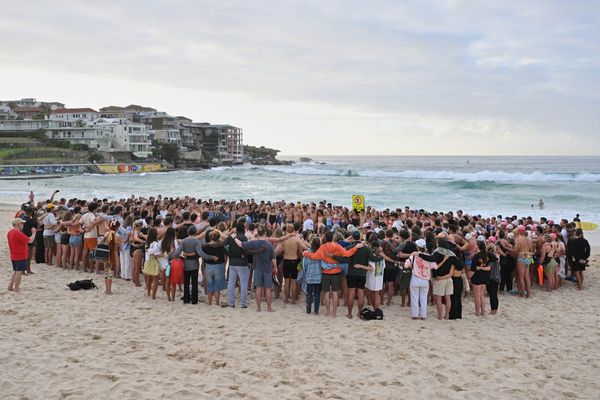
As I waited for the sun to crest over Colorado’s Front Range, adjacent to the sprawl of Denver–Boulder–Fort Collins, a west wind gusted, sending a shiver down my spine. With temperatures around freezing on a rocky ledge at 13,700ft, I searched for reprieve on the lee side of a boulder. I could see the city lights in the distance, but was more concerned with two headlamps approaching quickly, a few hundred feet below.
Between us lay a slab of coarse granite, known as the Cables Route. It’s the most direct way to the summit of Longs Peak, but is less travelled because it’s rated a class 5 rock climb and often carries a river of verglas – black ice – running down it, which climbers must navigate.
This was how I started the first morning of Kilian Jornet’s latest personal endurance project, States of Elevation. In it, Jornet would summit the highest 72 mountains in the contiguous US – every peak above 14,000ft – all under human power, cycling between and running up each one. I was along to document the literal and figurative highs and lows, as Jornet attempted, in layman’s terms, to run a marathon and ride a Tour de France stage every day for a month.
Widely regarded as the greatest mountain athlete of all time, Jornet grew up in Refugi Cap de Rec, a mountain hut in the Pyrenees of north-eastern Spain. With a father who worked as a mountain guide and a mother as a schoolteacher, Jornet summited his first peak before the age of five. At 20, he was the youngest ever to win the Ultra-Trail du Mont Blanc (UTMB), considered the World Series of ultrarunning.
Over his two-decade career, Jornet has set speed records on Aconcagua, the Matterhorn, Denali, Kilimanjaro and Everest; won the triple crown of ultrarunning – Western States, Hardrock and UTMB – and dominated shorter trail races, with 10 wins at Sierre-Zinal and 11 at Zegama-Aizkorri. He’s a world champion ski-mountaineer, bestselling author, founder of the shoe company NNormal, and a physiology obsessive who often uses himself as a guinea pig to see how his body adapts under stress.
Despite the accolades, Jornet remains soft-spoken and modest. While his racing success has bolstered his career and helped him accrue almost 2m Instagram followers, he’s leery of fame, sharing with me that many of his favourite days are solo adventures in the mountains. As he’s got older, he has shifted from racing to audacious endurance efforts like this one.
Longs Peak was the start of a journey that would take him more than 3,000 miles across six states, culminating on Mount Rainier in Washington. Meanwhile, my challenge – outside of joining Jornet for a peak here and there – was to write about the journey candidly, without overusing hyperbole to endorse his otherworldly efforts, an easy trap to fall into. Almost every day Jornet did something that would qualify as the biggest, fastest or hardest, but piling on superlatives would strip his feats of their full value.
At 3.30am I began hiking uphill, an hour before Jornet and Kyle Richardson, the current record-holder on Longs, started their ascent. Now, from my vantage above Cables, I watched the two dance across a section known as the Boulderfield and begin the technical climbing. I had taken my time on this part, carefully avoiding wet, icy and mossy handholds, and assumed they would do the same. To my surprise, their pace slowed negligibly as they scaled the vertical pitch, moving so carefree I doubted they noticed the sheer thousand-foot cliff a couple of dozen feet to their left.
As they drew closer, I could hear them chatting casually about past adventures, like old friends on a shakeout run. Technical alpine rock, ice and snow is where Jornet feels most at home, and where he radiates the most joy. He arrived at my perch with an ear-to-ear grin, gave me a quick fist-bump, and we continued upwards together.
On the top of Longs, Jornet paused to take out his phone and snap a few photos, which he would later send to his wife, Emelie Forsberg, also a professional mountain-runner, and their three young daughters. Despite the perception that Jornet’s life is dedicated to chasing the edge of possibility, nothing means more to him than family. Even after days with 20-odd hours of non-stop movement through the mountains, Jornet would try to call home.
For him, this moment had been years in the making. In 2023 he climbed all 177 3,000m peaks in the Pyrenees in just eight days. The next summer he summited all 82 4,000m peaks in the Alps in 19 days, using only human power to connect them. Looking for a similar adventure that would let him explore a new landscape, Jornet landed on the American West.
It was the perfect nexus of his curiosity about the body’s limits and a drive to understand threats to American wilderness, through both personal experience and conversations with locals along the way. If that wasn’t grand enough, Jornet decided he would follow, in his words, “the most aesthetic line”. When he first shared this with me in late June, I wasn’t sure what he meant. But I was about to find out.
After summiting Longs, Jornet could have turned around, run down, and ridden to the next peak, saving hours and considerable energy. Instead, he chose to traverse the 38-mile LA Freeway, an off-trail route with 21,000ft of climbing and descent, which took him the rest of the day. I initially found this odd, but as the days passed I grew to appreciate the value of aesthetics in the mountains – in part because it’s emblematic of Jornet himself.
Jornet is a minimalist who often goes hours without food or water. He’s an environmental advocate who believes in protecting wild places. He’s so proficient in technical terrain that it comes as naturally as walking. But above all, Jornet is an artist. Projects like States of Elevation are how he leaves his mark: encouraging others to explore wild places, without leaving scars on the land itself.
On my third day with Jornet, as we climbed Grays Peak in the late afternoon as the tail end of a lightning storm blew through, I asked about his motivations. He explained it wasn’t about speed, records, or even anyone else knowing about it. If he wasn’t a famous athlete, he would still have done the route, likely with less support and fanfare. The purpose was so obvious to him it was almost hard to explain.
To Jornet, the mountains are a necessity. He wanted to see the remote ranges of Colorado, feel the vastness of basin-and-range country, and grasp the vertical relief of the Cascade volcanoes, because being in these places gives him life. He also feared that some of these landscapes might not remain public or protected for long. But the most important part was what he left unsaid.
A few days later Jornet ran the Elks Traverse, a 50-mile technical scramble near Aspen, Colorado, that has only seen a handful of finishers. The next day he completed Nolan’s 14, Colorado’s most notorious fourteener link-up, with just a 30-minute nap in between. Like a savant with a blank canvas, Jornet was etching the most beautiful line through these mountains. To him, this was art.
On my last day in Colorado, I hiked up the backside of Mount Massive and met Jornet near the top. The sun had set and the sky was turning a hazy blue as the last rays disappeared. We paused a few hundred feet below the summit, watching a family of four mountain goats graze, unconcerned by our presence.
Jornet, fluent in five languages, looked at me and said: “There’s a lot of wildlife here.” In the previous week we had seen moose, black bear, elk, goats and coyotes – a sign of a diverse ecosystem and expansive wilderness that no longer exists in the Alps or Pyrenees. It was a reminder to stay grateful for the wild places we do still have, because they are far from guaranteed.
A week later I rendezvoused with Jornet in southern California, after he had pedalled 900 miles in five days from Colorado. The next morning he began Norman’s 13, a 100-mile route with 39,000ft of climbing, connecting all of the fourteeners in the Sierra. I joined him for a quarter of the route, split into three sections, watching as he lowered the fastest known time by a remarkable 18 hours.
For most people, this would have been an unrelenting pace across one of America’s most remote ranges. For Jornet, it was two composed, introspective days in the wilderness. On our climb up Glen Pass in Kings Canyon National Park, he paused, looked down the valley, and said: “It’s beautiful,” before carrying on. It may sound trite, but the sentiment was anything but.
Jornet has spent considerable time in the most remarkable mountain ranges in the world – Andes, Himalaya, Alps and Alaska – yet remains in genuine awe at every corner. For the rest of that day, I found myself appreciating what was in front of me, instead of letting my mind wander. Our lives are often so busy and complicated we lose sight of the important things right before us.
On my last day in California, I met Jornet on Thunderbolt Peak, after he completed a technical ridgeline called the Palisade Traverse, covered in snow and rime ice. Despite just two hours’ sleep in the prior two days, Jornet was surprisingly lucid. As he stopped to eat a sandwich, I asked what he thought of the route. “I would do it again,” he replied simply.
I’m not sure if Jornet meant the Palisades, the Sierra, or the entire route, but I am sure that when he does come back, it will be an even more aesthetic line.







